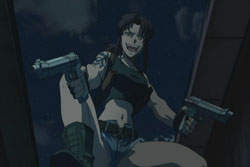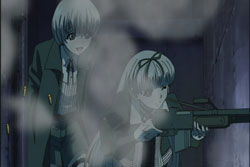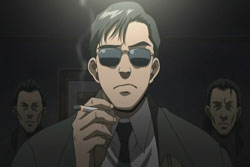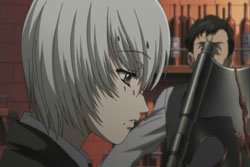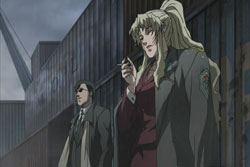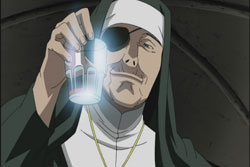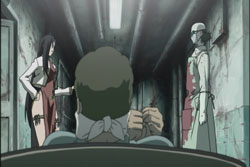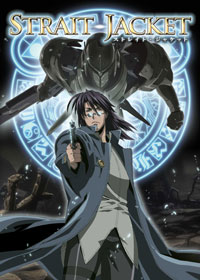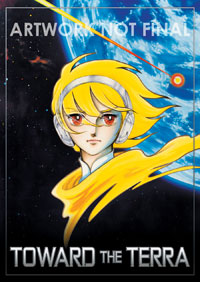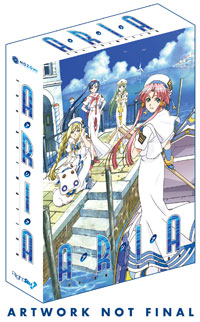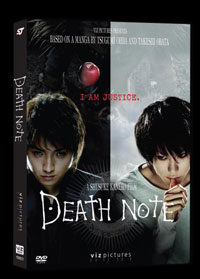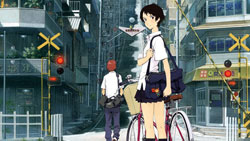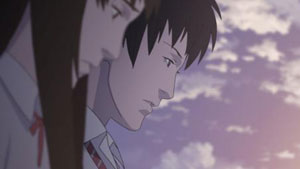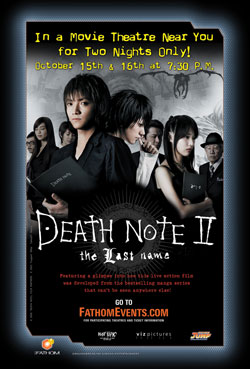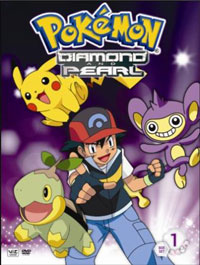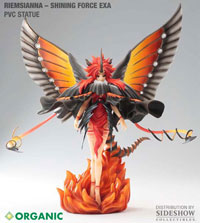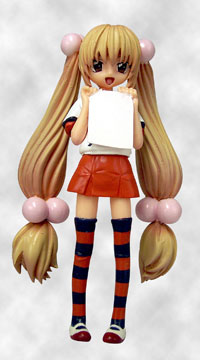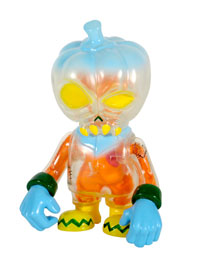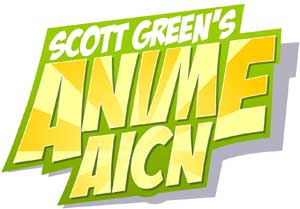 Logo handmade by Bannister
Column by Scott Green
Logo handmade by Bannister
Column by Scott Green
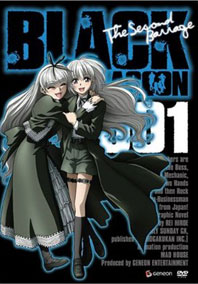
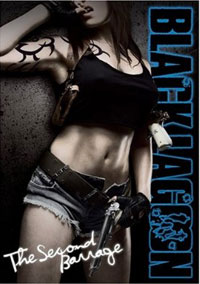
Anime Spotlight: Black Lagoon Second Barrage: Volume 1 Released by Geneon, Distributed by FUNimation
It's been about a year since the release of the last volume in the first Black Lagoon season, during which time stuff happened. While there was not much of a break between season one and season two when they aired on Japanese TV, think of it this way, within the context of the show, there is a reference to something like a year passing between former Japanese salaryman Rokuro Okajima taking up the moniker Rock as a member of the mercenary odd job enterprise at Lagoon Company and the events of Second Barrage. It was a dark and stormy night... Moving past defaced Buddhist statues, past prostitutes huddled in door ways and strip clubs that look especially subdued, Second Barrage picks up a bit of a conversation in which two children ponder whether Edger Allan Poe, Richard Matheson or maybe someone else coined phrase "the ultimate love is cannibalism." Pair of bag men walks into a club and are met with machine gun fire and dismembering axe blows.Set in an East Asian Wild West, Black Lagoon is populated by gunslingers with a primal comfort with violence or ancillary participants, disconcertingly acquiring that ease. Second Barrage jumps in by sticking up Jesse James. Well armed cousins of the Shining Twins crash the town's criminal enterprises. At which point, the heavies accustomed to causing others to wet themselves start watching their own backs. Black Lagoon, or more specifically, writer/director Sunao Katabuchi gets that anime has normalized a hell a of lot. A girl in a bikini top carrying a six foot sniper rifle? It took me a moment to reason out why Gurren Lagann was "suggestive." If you live in place a without squirrels, watching gray, tree climbing mammals with fuzzy tails might be captivating. If you don't watch much anime, the notion of a child hefting a machine gun might be electric. As an anime fan... killers, and killer maids, and killer children... it all largely looks recycled at this point. Without taking any audience reception for granted, Second Barrage does not wait before aiming a shot in the guts with the twins' blood letting. Before you can second guess or question whether its been played, Black Lagoon has been reestablished as the anime you don't want to show your back. It provokes a clenched jaw rather than yawn or rolled eyes at its child killers by selling the combustibility of the danger and reminding the viewer that while they may have seen children shoot to kill in other media, it is never an idea to be accepted comfortably. The twins sink their fangs into the jugular of anime's criminal community. What they do to a man bound in a chair makes Mr. Blonde's dance look like a naughty child tweaking a dog's tale. However, it's the point of view that these twins are rabid animals with instincts that are sufficiently keen to allow them to survive long enough to cause real havoc that cinches the tension. Black Lagoon previously established that its cast has been molded by their own traumas and mortal confrontations, often early in their lives and or for prolonged periods. Seeing the murderous and self destructive sweat those who they in turn regard as murderous and self destructive clarifies the magnitude of the situation. Then, when a triad boss/A Better Tomorrow Mark Gor stand-in and a bomb-scarred Russian officer turned mob queen massage their brows and curse the futility of even condemning the events that lead the twins to become killers, the anime treads into some hauntingly dark nihilism. Stepping back to regard the series as a whole rather than just Second Barrage, in 2007, I was telling people that Black Lagoon is THE anime to see. What I expressed on AICN was: While its level of violence is a substantial liability in finding a high profile spot on North American television, Black Lagoon is ready to weigh in as a serious contender for supplanting Cowboy Bebop's audience. By out Hollywood action-ing Hollywood action and setting a tone that is neither ponderous nor disengaged with the state of the world, Black Lagoon is an aesthetic success. In all likelihood, commercial success will follow suit. Early that year, I was at the MIT-Harvard Cool Japan symposium to listen to the speakers. Talking to people afterwards, I was saying "see Black Lagoon." I didn't know whether their tastes included an appreciation for heroic bloodshed and whether they wanted to see an anime featuring a Chinese American sociopath in a black sleeveless shirt and daisy dukes gunning down assorted criminals in a seedy Thai port. The intent behind the recommendation was to point out Black Lagoon's place among the anime from a range of sources formulated to capture the attention of international audiences. At the time Afro Samurai had recently aired on Spike and Highlander: Search For Vengeance was a few months off. After re-watching Afro Samurai a few time and giving it some thought its review, I found considerably more to like than when I was first processing it, but with my new appraisal, as well as later internationally minded efforts such as Batman: Gotham Knight and Applseed: Ex Machina, I still believe Black Lagoon is international anime at its best. One key to Black Lagoon's success, inherited from the manga by Rei Hiroe (aka, sometimes pornographic doujinshi artist TEX-MEX) is that the series paints from a palette inked with global culture and global pop culture. The fictional Roanapur, Thailand is surrounded by a ring of tranquility suggested in a harbor gated by monumental Buddhist statues and the natural jewels of the groves and aquatic life. It is not until the bridge to the outlying town that the hangman's noose crops up and all the bird start repeating death threats. Founded or transformed as a Viet Nam war dumping ground, the city became a mound of emotional baggage washed ashore on paradise. Now, it's home to veterans of America's war with Viet Nam, the Soviet Union's war with Afghanistan, Latin American cartels, Italian mafia, Hong Kong triads, CIA adventurers, modern pirates... Basically, anyone who might be quick to pull a gun out of desperation or to prove a point. Out of this criminal Galapagos, various unique people and enterprises evolve, such as the Catholic Church/gun running organization, The Church of Violence aka Rip-off Church, and various pop culture Frankenstein monsters are stitched together, such as an ex-FARC turned black and lace clad maid in the house of a cartel who comes on like a Terminator, or a chain-saw wielding slasher-loli-goth who speaks with a Ultravoice courtesy of a cut throat. Popular anime's record for ethnic characters is mixed to say the least. Even somewhat smart sci-fi like Gene Shaft or Argento Soma are given to trading in outrageous racial stereotypes. Slap yourself on the forehead every time there is a grooving, tribal or dim character of African descent in anime and you'll retire from the past time with post-concussion syndrome. Black Lagoon does play with these stereotypes to some extent. Even if she's hiding a few cards, the Church of Violence's Sister Eda is essentially the loud, balloon chested American blonde, while the Taiwanese knife for hire "Chinglish" Shenhua is the kindof batty, ethnically Chinese woman who pops up in anime comedies. One difference is that when said American starts John Wayne-ing a comparison of hunting deer to coyote, or the Taiwanese woman drops the giddiness to make it clear that she will not tolerate a loud mouth fucking with her national pride: A) there is the charge of seeing particular species of hard-ass attitude on display B) there is the self-identification charge of "my (national/ethnicity); fuck yeah!" Beyond that, Black Lagoon brings in the sort of global conglomeration found in select genre works like Snow Crash or Global Frequency. East Indian currency forger "Greenback Jane" is the kind of character who'll find their way into Black Lagoon and few other anime. Sunao Katabuchi's spin on Black Lagoon is that as it exalts in violence, it's ambivalent towards that excitement. One of the first season's early action set pieces, featuring a torpedo boat chase, expresses this sentiment clearly. With enemies approaching, Revy (the Chinese American in the sexy outfit) reflexively adopts a shark's grin before literally leaping into an audacious gun fight. After Revy more or less single handedly executes a score of men, Rock applauds her work. Under his breath he remarks "I don't know what broke to make her like this, but I must be broken too if I'm standing here praising her destructiveness." Black Lagoon is not purposefully focused on the effect of violence like a Now and Then, Here and There. It's not humorless and it's certainly not restrained or self serious. Post twins smoz, Revy wakes up in a sweltering afternoon, having buried her room in a new layer of empty beer bottles AND having shot up her air conditioning unit. Similarly, Black Lagoon will get blasted, but it will also feel hung over afterwards. There is a sense that character, creator and viewer are all addicted to the spectacle of violence, and maybe that's not something to feel good about.
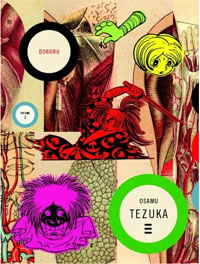
Manga Spotlight: Dororo Volume 3 By Osamu Tezuka Released by Vertical
"Tezuka manga are brilliant" is a bit reductive, but it is also almost axiomatic. Alternatively, the proposition that Tezuka manga is flawless could be argued against using Dororo, and honestly, a fair amount of his body of work. Not every manga work by Osamu Tezuka is a sterling testament to the power of the medium. Big X, his Nazi superman who transformed by injecting himself with a magical amulet, sounds like awesome pulp manga in the lineage of works by Go Nagai or Takayuki Yamaguchi; it also sounds like something that would only interest boys, genre historians and the irreverent. Tezuka is remembered and revered as the "God of Manga" for the ability to write about a drug fueled Nazi weapon, and in the same years, write Princess Knight, (Big X and the third version of Princess Knight both ran 1963-1966). That genre defining classic concerning a young woman with both male and female hearts explored fairytale stories from the prospective of both genders, and in doing so, laid the foundation for shoujo manga. In a life time of work that included 700 manga with more than 150,000 pages, Tezuka produced a prodigious amount of titles whose creativity, sophistication and artistry transcended their ephemera origins. Dororo is one of his works of Bookshelf Manga that is worth holding onto for its artistic value rather than as another space in a stack of enjoyable diversions. It's a reaction to Shigeru Mizuki's GeGeGe no Kitaro (Cackling Laugher Kitaro), also known as Hakaba Kitaro or "Graveyard Kitaro." Which is to say that it concerns itself with the slimy or strange, unhuman things creeping beyond the horizons of natural experience. Like other Tezuka manga, from Astro Boy's "Once Upon a Time" to Mw, it is also a reaction to the Vietnam War. Combining the two currents, Tezuka has a scarred, torn apart swordsman track down ghouls in remote, haunted locations. He twists established legends, working his interpretations of the rat monk Tesso and the chimera nue into volume three (see Yokai Attack! for further reading on the subject) as well as his own creations. Utilizing his flare for the cinematic, Tezuka constructs indelible images of these ghostly echoes of the sins of greed and cruelty. Dororo deserves a reputation, and in informed North American manga reader circles it has had one. Part of the reputation is that it's a strange journey into highly allegorical, violent weirdness. And part of the reputation is that this swords and spirits gem does not exactly end as artfully as some of Tezuka's planned epics, such as the karmic convolutions of specific works in his Phoenix cycle or Adolf with its epilogue set a generation after World War II. Truthfully, though not necessarily as incomplete as this column previously suggested, Dororo experiences trouble in its wrap-up. As the official site explains: Though this work's serialization was never finished, the animated program for television was broadcast later on. "Dororo" was completed with a "Part II" series, which was published in the monthly magazine "Boken-o" Tezuka has two characters with story arcs literally imprinted on their composition. There's Dororo. Despite the naming rights, Dororo is actually the sidekick of the manga. A late development in volume 2 was that the back of this orphan thief is tattooed with a map to a treasure hidden by the character's massacred bandit chief/populist revolutionary parents. Then, there is "”Hundred-Demon Boy” Hyakkimaru, the survivor of a demonic sacrifice whose will to live allowed him to survive being born without limbs, eyes, nose, ears, vocal cords... Given swords and a prosthetic body by the doctor who raised him, he hunts the 48 demons who inherited his natural limbs and organs. The check list of goals to accomplish is evident. Reconcile Dororo's parent's legacy. Take back Hyakkimaru's body piece by piece. Settle with the people responsible for Dororo's parent's fate and the pact that robbed Hyakkimaru of a natural life. While Dororo is born into the heart of Sengoku period Japan's endemic war and famine, Hyakkimaru discovers the condition in his travels. Confronted by hardship exacerbated by the supernatural, but like his own condition, caused by human sins, Hyakkimaru's quest drives a colder and more cynical outlook into his perspective. Tezuka seems compelled by the irony of a character who is barely human from a physical standpoint, but defined by his will to live, becoming more ambivalent towards life and humanity as he reconquers his human form. Apart from this, Tezuka employs that check list of goals for structure and little else. He seems to have been creatively intrigued by the origins of the pair and by what they encounter rather than the entirety of their stories. Coming to manga from familiar American serialized popular media, such as television or super-hero comics, one of the impressive traits of the manga tradition is its defined endings. This is by no means a universal characteristic of manga and more American media have taken to being planned and finite, but it has been memorable to see Death Note or Card Captor Sakura conclude after 12 volumes. Even creators like One Piece's Eiichiro Oda, whose works churn in popular anthology year after year, insist that they have definitive endings planned. As such, there is an expectation for Dororo that the manga does not meet. Dororo ends with an abruptness that suggests necessity rather than inspiration or prepared finality. If this were an essay exam, Tezuka would have been frantically rushing to complete his argument before "pencils down!" Dororo's past is dealt with, and it's fitting even if it isn't provocative or clever in its own right. Hyakkimaru specifically says "I still lack a couple dozen body parts" before running into the confrontation that will clear most of the red ink in his vengeance ledger. To borrow a book title, "and then we came to the end." The issue is not that Dororo doesn't have an ending, it's that rather than being mythical or insightful, it rings of a manga author closing down a series. While Tezuka wasn't keeping an eye out for prime parking spots to leave off the manga's key passengers, he was still evidentially involved in telling the story of a last few yokai spirits, and more significantly, visualizing those stories. There are spooky legends that you never forget because you were first exposed to them as a child. And there are spooky legends that you never forget because of their vividness; a Poe or Hawthorne story for example. The latter is the case with Tezuka's manga. Dororo is vivid enough to reshape associations. Personally, I see volume three's overcrowded boat of samurai at the mercy of a demonic shark coming to mind the way that John Singleton Copley's "Watson and the Shark" does, the rat priest in a meditative pose, staring into the dark with unblinking, beady eyes coming to mind the way that TMNT's Rat King does, and the spirit who forces a food horder to eat by striking a chime coming to mind the way that Se7en's Gluttony does. This sort of staying power goes a long way in making the mediocre into a classic. Curse of the Yoma only had a ghost horse and a creepy performance of the Counting Song going for it. Even if this would not be regarded as one of the better anime released in North America, the fact that people who watched it over a decade ago remember that horse and that song speaks of the power of the anime. Dororo has that memory etching sharpness, but it also has Tezuka's inventiveness and genius for the medium, in which he seamlessly transitions from Kurosawa like cinematic perspective, to cartooned energy to grandiose, print-like still shots.
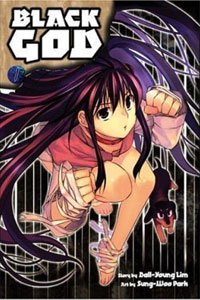
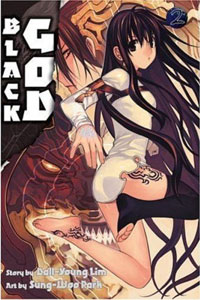
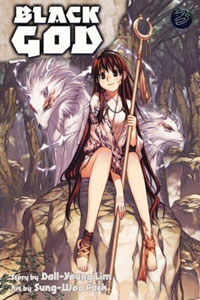
Manga Spotlight: Black God Volumes 1 - 3 story by Dall-Young Lim art by Sung-Woo Park Released by Yen Press
At its best, Black God is a kung fu fairy tale - while exploring the hidden rules that govern human destiny, factional Mototsumitama demi-gods battle it out with savage intent. The manga's first throw down features titular child-like goddess Kuro ("Black") taking grief for fighting like a human with jabs and crosses rather than striking down her enemies with god-lasers or something to that effect. However, the manga is at its best when showcasing super-powered boxing or jujitsu. Glowing seals materializing or stampedes of clone duplicates charging onto the battlefield are all well and good in a super-power action manga, but a kid weaving and hooking, trying to box a pack of motorcyclists or an angry goddess shooting a double leg takedown then cracking the earth with her ground-and-pound attack literally kicks ass. While by no means universally adhered to, the convention in super-hero comics is that someone employs super powers or they employ martial arts. You have a Superman, a Spider-man or an Incredible Hulk who can lift cars, but who wings it on technique. Or, you have a Batman or Daredevil, who, from a conceptual standpoint, are limited to what a well trained athlete could accomplish, but know what they are doing. Nor is this unique to American super-hero comics. On the manga front, there are works like Dragon Ball, a series that purports to be a martial arts story, but especially as it progresses, becomes a contest of super-powers. The fact that Black God looks to model its action after identifiable martial arts or combat sports does not mean that it is particularly careful or particularly accurate. Of the manga/manhwa being released in North America, Shaman Warrior, or, after its own outrageous fashion, Tenjou Tenge are more concerned with getting the details correct. In this case, the manga seems to be working off fan-ish notions of boxing or grappling, and to the extent that this sloppiness translates to the characters themselves, it is a liability. Maybe the boxer wouldn't get a flying boot to the face if her fists weren't chambered by her ribs. But, if the details aren't there, the excitement is. Seeing Kuro quickly cut angles like Bruce Lee or Spike Spiegel (same difference) then punish her target with volcanic strikes is reason enough for an action comic/manga fan to seek out Black God. Beyond the fist fight of the spirits side to Black God, it is a surprisingly conventional manga from an unconventional set of manga creators. In justifying the "manga" classification in their encyclopedia, Anime News Network offers "Although it was first published in Japanese, Black God was first written in Korean, then translated into Japanese and published. Because this title was created for the Japanese market, it was originally created in the right to left format of Japanese manga, not the left to right format of Korean manhwa. Other titles created by (writer Dall-Young) Lim and (artist Sung-Woo) Park were created initially published in Korean in left to right format." The more manga you read, and more anime you watch, the more Black God will provoke dejavu. This is especially, true in the early chapters, but even into volume three, there is plenty of "that's like Bleach, that's like Fullmetal Alchemist, like Welcome to the NHK... like Fate/Stay Night... Kanon..." Keita Ibuki lost his parents at an early age. As a child, he was walking with his mother when the pair spotted a woman that looked identical to Keita's parent. The next day, his mother died. His father, who had previously been a creature of the office, remained away from home in the wake of his wife's mysterious departure. The years pass, and Keita Ibuki grew into a self-absorbed 19 year old who moved to Tokyo to pursue a career as a video game producer and leech off his slightly older childhood friend, now employed as an office lady. On a fateful night, after mooching some funds offs his friend and offending the two colleagues working on his video game, he ends an night of excess by stopping at a roadside noodle booth. The meal is interrupted by the arrival of a dirty, homeless looking girl wearing nothing but a raincoat and dog collar. Keita shares his ramen with the girl. After he reminisces about his own childhood insistence on ramen and missing his mother, the mysterious girl, Kuro begins correcting Keita between mouths full of soup. The woman that his mother met was not one of two doppelgangers, but one of three doppeliners. She goes on to talk to a complex system of spiritual energy distribution and the way in which fates can be absorbed or poisoned. The introduction to metaphysical accounting is interrupted when a Mototsumitama from the Shishigami clan bursts into noodle stand and begins assaulting Kuro. Keita responds by clubbing the guy with his chair, a move which ensues that his fate is intertwined with Kuro's. The best and worst quality of Black God is that it withholds its mysteries and little else. Though the world of Mototsumitama and doppeliners is complex upon introduction, the manga periodically reveals even more convolutions. Beyond that, the manga exercises Chris Claremont style plotting with a horizon that is crowded with people in shadows, doppeliners who may or may not be in play, unstated agendas, and so on. When not dealing with one of these mysteries, Black God is quick to deliver. Most threats are presented, then quickly executed. For example volume two heats up its fight between boxing Kuro and a jujitsu fighting Mototsumitama to a boil over the course of that particular volume. Dall-Young Lim directs Black God towards a lot of the excess common in the manga/anime tradition. There are numerous tropes in these media that are potentially offensive for their gender politics, or potentially offensive in their condescension. There's what North American fandom call's harem, in which an unimpressive guy never the less manages to win the affection of a host of attractive, interesting women; there is magical girlfriend, in which an unimpressive guy never the less manages to win the affection of a woman who is so impressive, so exotic, that she's literally magical; there is moe, in which a quality such as innocence is fetishizedl there's lolicon, a "lolita complex" attraction to youthful character. Black God loads up its candy bag with handfuls of all of this. From the standpoint of someone who is not moved by these tropes, the aggravating factor is that Black God is consciously forthcoming with justification for these behaviors. Keita might seem like an irredeemable twit who abuses the generosity of others, but when women cling to him, the reader is reminded explicitly in the dialog, and during the critical points in the action that he does in fact have a noble heart. There is a European Mototsumitama with his human companion who look like a healthy middle age man and a young girl, but the manga explains that she's of an unknown older age and looks childlike as the result of a mutation." Black God is not a series that wants to explore ideas beyond its own concept (doppeliners and spiritual energy). As such, it consistently offers rationale for why it can present an idea without making it a topic to be pondered. Considering both the super powered beat-em-up and the character conceits, Black God commits to deliverying what people who like genre manga like. If you're interested reading about a scruffy kid laying down the science and seeing bishojo (cute young women) in dangerous situations, know that Black God make it its mission to get your number.
No Akira for Joseph Gordon Levitt?
MTV's Splash Page Blog have spoken to Joseph Gordon Levitt about rumors that he will be the Tetsuo of Warner Bros. and Leonardo DiCaprio’s Appian Way's live action Akira. “That just goes to show what you can believe about what people write about movies. I love the movie ‘Akira.’ I still have yet to read the manga, but that’s really just a rumor. They don’t have a script or anything.” So while Levitt doesn’t necessarily say he’s not attached, it looks as though fans of what is arguably “The Godfather” of modern manga/anime properties will have to wait a bit longer before any official word comes out.
Sky Crawlers US Bound
Following the recent festival circuit, Sony Pictures Worldwide Acquisitions Group acquired the rights to Mamoru Oshii's new animated film, "The Sky Crawlers" for distribution in U.S., Canada, Latin America, Australia and New Zealand. Oshii's work adapts the Hiroshi Mori novel concerning children fighting an aerial war. The Sky Crawlers was recently recognized with the Future Film Festival Digital Award at the Venice Film Festival Japanator and Tokyograph, recently reported Mamoru Oshii (Ghost in the Shell), Kenta Fukasaku (Battle Royale) and two other directors are prepare a live action project called "Kiru ~ KILL." The omnibus will be composed of sword fight climaxes cropped from the framework of larger dramas. Oshii's segment, called "ASSAULT GIRL2," stars Rinko Kikuchi and Yoko Fujita as two women, dressed oppositely in black and white, silently battling on an open field. Kiru ~ KILLis scheduled to open in Japan on December 6th.
Hollywood Detroit Metal City in the Works?
The Sports Hochi and Anime News Network reports that TOHO is receiving offers for a Hollywood remake of rock manga turned live action movie Detroid Metal City. Detroit Metal City concerns a farm boy turned KISS style rocker. The live action film has distribution agreements for Hong Kong and South Korea. Distribution offers are said to have come from 25 other countries and regions, including the United States, the United Kingdom, France, Germany, Taiwan, Australia, and Brazil.
New and Upcoming in Japan
A report on the recently released Gurren Lagann movie with program scans. Translated here MoonPhase rumor has it that a sequel to the anime adaptation of light novel series Spice and Wolf is in the works. The series follows a young peddler and a wolf goddess. Via Anime News Network The new issue of Fujimi Shobo's Monthly Dragon Age announced that a new, fifth season of The Slayers, entitled Slayers Glory is in the works. The ongoing Slayers Revolution television anime series was conceived as the first part of a storyline that will last half a year (with a break in between). Gonzo is adapting Eiichi Ikegami's Shangri-La science-fiction epic novel about global warming's transformation of Japan. Makoto Bessho (Ah! My Goddess: The Movie, Armitage: Dual-Matrix) will direct off the scripts that will be supervised by Hiroshi Ohnogi (Arjuna, Noein - to your other self). Takeshi Mori (Otaku no Video, Vandread) will be the creative producer, and famed illustrator Range Murata (Blue Submarine No. 6, Last Exile) will design the characters. Shingo Takeba (RahXephon, Eureka Seven) is serving as creative supervisor over a team of designers that includes Takuhito Kusanagi (Blue Submarine No. 6, Samurai 7), Hajime Satou (Karas, Solty Rei), and Umanosuke Iida (Mobile Suit Gundam: The 08th MS Team, Tide-Line Blue). Waki Yamato's historical shoujo Asakiyumemishi - The Tale of Genji, based on the classical literature, will be adapted into anime Zettai Yareru Grecia Shinwa, a live-action/anime hybrid, "slightly risque/ecchi" retelling of Greek myths will air on Japanese TV starting in October. Chocolate Underground, the Production I.G anime TV series adaptation of Alex Shearer's novel Bootleg, will be editing into a theatrical movie with 20 minutes of new footage. Mecha series Hades Project Zeorymer will be revived with a Hades Project Zeorymer Omega manga running in Tokuma Shoten's Monthly Comic Ryu. Morio Chimi (Bio-Booster Armor Guyver) will be working with artist Yu Watari on the new Omega manga. Yoshio Sawai ( Bobobo-bo Bo-bobo) launched Chagecha, an "earth-shattering, hilarious action manga" about a "great delinquent" in Weekly Shonen Jump Tohru Uchimizu (Kain) launched the ongoing "medieval medical drama" manga Asklepios. A Asklepios one-shot was previously published. Shueisha's Jump Square magazine announced Kentaro Katayama's Denpa teki na Kanojo ("electromagnetic girlfriend") light novels will be adapted into anime. New trailers/previews Armored Trooper Votoms: Pailsen Files movie Battle Spirits Shounen Toppa Bashin Nodame Cantible Paris Hyakko Slap Up Party - Arad Senki
Upcoming North American Releases
Manga Entertainment will be releasing Ichiro Sakaki's (Scrapped Princess) Strait Jacket on October 7th for $19.97. Strait Jacket is produced by Feel (Jinki: Extend TV and Kissxsis OVA) and directed by first-timer Shinji Ushiro. Character designs are by Yoshinori Yumoto (“Fullmetal Alchemist,” “Planetes”), and boasts an all-star English dub cast, with Crispin Freeman (Hellsing, Ghost in the Shell: Standalone Complex) and Kari Wahlgren (Samurai Champloo, Steamboy) Created by Ichiro Sakaki (Scrapped Princess), Strait Jacket was a sensation from the moment it aired in Japan earlier this year. In a world where sorcery and science co-exist, the power of magic comes with a price: Humans who do not take proper precautions are transformed into horrific demons. Those who destroy these demons – and run the highest risk of all – are tactical sorcerers known as ‘Strait Jackets’. But when terrorists unleash a plague of demonic carnage, the Sorcery Management Bureau must enlist unlicensed assassin Leiot Steinberg to stop the slaughter. Even if this rogue killer and a mysterious young girl can end the outbreak, will they be able to face their own dark secrets? The DVD will be packing in a spectacular holographic “O-card” cover.* Anime producer and distributor Right Stuf, Inc. and Nozomi Entertainment announced the first North American DVD release of the TOWARD THE TERRA movie on November 25, 2008. The upcoming edition of the Toward the Terra film, will feature remastered video footage from its 2007 Japanese DVD release, Japanese audio and English-language subtitles. Keiko Takemiya’s original manga, known as To Terra… (Terra e…), won both the prestigious Seiun Award for science-fiction manga and the Shogakukan Manga Award. It is published for English-speaking audiences by Vertical, Inc. The television anime adaptation is released in North America by Bandai Entertainment. In the future, mankind’s seemingly utopian society is strictly controlled by the government, and anything that threatens to disrupt the status quo is ruthlessly suppressed. When 14-year-old Jomy begins to question the way the society is run, he suddenly becomes a target for both the government and the Mu, an outcast race with extra-sensory abilities who have been fighting against the government for generations. Now, each is determined to hunt him down – one to kill him and the other to save him.TOWARD THE TERRA Film © 1980 Toei Animation Co., Ltd. All Rights Reserved. © Keiko Takemiya, Toei Animation Right Stuf, Inc. and Nozomi Entertainment will be releasing MARIA WATCHES OVER US (Maria-sama ga Miteru) - Season 2 DVD Collection: Printemps on November 25, 2008. The four disc set will be released for $49.99. The Maria Watches Over Us anime is based upon an ongoing series of novels – written by Oyuki Konno and illustrated by Reine Hibiki – that began in 1998 and currently spans 33 volumes. Short stories related to the series have been published in the shoujo (girls’) magazine Cobalt, and a manga adaptation is serialized in the anthology magazine Margaret. The series’ publisher, Shueisha, also produced 14 drama CDs (featuring radio-style plays). MARIA WATCHES OVER US (Maria-sama ga Miteru) PRINTEMPS © OYUKI KONNO / SHUEISHA • * The DVD sampler included with OTAKU USA Magazine’s October 2008 issue, now on newsstands features a preview, subtitled episode of pastoral sci-fi, set on a terraformed Mars, Aria The Animation. The ARIA THE ANIMATION DVD Collection – which includes the franchise’s entire 13-episode first season – is scheduled for release on September 30, 2008. ARIA The ANIMATION is the first of three television seasons, plus an OVA (original video animation), that comprise the anime adaptation of Kozue Amano’s best-selling Aria manga. The ARIA anime is helmed by Director Junichi Sato (Princess Tutu, Sgt. Frog, Sailor Moon/ Sailor Moon R) and features animation by Hal Film Maker (Boys Be…, Pretear, Slayers Premium, Sketchbook ~full color’S~). The franchise’s third season completed its TV Tokyo broadcast in March 2008.* VIZ Pictures, September 16th DVD release of the live-action film, DEATH NOTE, based on the popular manga and animated series. The DVD features a newly dubbed English soundtrack, along with the original Japanese dialogue with English subtitles. Special bonus features include an interview with the film’s director Shusuke Kaneko, an insightful “Making of DEATH NOTE” segment and the original theatrical trailers. Based on the hit supernatural action mystery manga series written by Tsugumi Ohba and illustrated by Takeshi Obata, DEATH NOTE was released in Japan in 2006 and mirrors the manga’s story of Light Yagami, an ace student with great prospects who is bored out of his mind. All of that changes when he finds the Death Note, a notebook dropped by a rogue Shinigami death god named Ryuk. Any human whose name is written in the notebook dies, and now Light has vowed to use the power of the Death Note to rid the world of evil. But when criminals mysteriously begin dropping dead, the authorities send the legendary detective L to investigate, and he is soon hot on the trail of Light, who must now reevaluate his one noble goal. Both Light and L believe themselves to be on the side of justice, and the two match wits trying to show exactly which of them is "good" and which of them is "evil."* Via Anime on DVD FUNimation will be releasing a Viridian Collection edition of Gunslinger Girl Box Set on November 21st for $39.98 and Samurai 7 Box Set on Blu-ray December 9th for $79.98.* Sony Pictures Home Entertainment will be releasing Blood+ volume 3 on November 21st.* November Bandai Entertainment releases include 11-4 Lucky Star Vol. #4 (also w/Limited Edition) from Kadokawa Pictures USA Silent Mobius the Motion Picture 2 11-11 Gurren Lagann Part 1 (also w/Limited Edition) $39.98/64.9 (billingual verison) Gurren Lagann Vol. #1 Gurren Lagann Vol. #2 11-18 Girl Who Leapt Through Time (also w/Limited Edition) $39.98/64.9 Mobile Suit Gundam Seed Destiny TV Movie 3 Blu-ray releases from the Honneamise label include 11-11 Freedom Box Set $139.99 11-25 Diebuster the Movie $49.98 Gunbuster the Movie $49.98 Gunbuster vs Diebuster: Aim for the Top! The Gattai Movie $99.98
Event News
Providence Anime Conference talks up their video programming* The Girl Who Leapt Through Time will screen at the NYCFF this weekend. THE GIRL WHO LEAPT THROUGH TIME Japan, Animation, Mamoru Hosoda, 2006, 98 min IN ENGLISH - RECOMMENDED AGES 10 TO ADULT Sat & Sun, Sept 13 & 14, 11am - IFC Center, 323 6th Ave (at West 3rd) Tokyo teenager Mokoto Konno prefers to play baseball with the boys than gossip with the other girls. Stuck at a midpoint between child and adult and with graduation approaching, she's not too sure of what she'd like to do with the rest of her life--that is, until a mysterious accident in the science lab gives Mokoto the ability to leap (literally) back in time. Once she recognizes the life-changing potential of her newfound power, Mokoto's life becomes increasingly chaotic. In a series of breathtaking freeze-frame sequences, she plunges into the past in an attempt to manipulate fate in her favor; yet, it soon becomes painfully clear that she cannot avert the inevitable. More than just a visually stunning anime adventure, The Girl Who Leapt Through Time is a metaphorical tale of teenage angst: Mokoto's manic time-leaping reflects her deeper fear of growing up--a denial of creeping adulthood, of uncomfortable romantic feelings, uncertainty about her future, and a growing nostalgia for her simple high school life circumscribed by the baseball diamond and her two best friends. Tickets can be purchased here* Suvudu is hosting a contest for prizes includes manga and tickets to this year’s New York Anime Festival. Participants submit a manga- or anime-style self portrait along with a photo of their real selves for comparison, to be judged by Del Rey Manga’s own Ali Kokmen and Tricia Narwani. The contest runs 12:01 AM EDT September 10, 2008 and midnight on September 18, 2008. See Suvudu for Informaiton and rules* Fifteen Pound Pink Productions, the producers of Mr. Reaper's Really Bad Morning (covered here) will start bring their new Intergalactic Who's Who shorts to Canadian film festivals in the coming weeks. Intergalactic Who's Who: The Pork 'n' Being and Intergalactic Who's Who: The Praepredatorprae will be screened at Ottawa International Animation Festival IWW: The Pork 'n' Being, IWW: The Praepredatorprae and IWW: Zig 5 with recent Bravo!FACT in Toronto at the Royal Cinema (Sept 24)* The Somerville Theatre outside Boston will host Anime After Dark October 18.08 7pm - 7am Amoung the films to be screened included Grave of the Fireflies Ghost in the Shell: Solid State Society Project A-Ko Tekkon Kinkreet Millenium Actress* NYTFGP2008 FESTIVAL PART ONE will kick off on September 28th, 2008 at NYU’s Cantor Film Center. The line-up, which includes the New York premiere of GENIUS PARTY & GENIUS PARTY BEYOND and the North American premiere of the live action GRAVE OF THE FIREFLIES can be seen here* VIZ Media and NCM Fathom will be presenting the second live action Death Note film in theaters October 15th and 16th. For a list of participating venues, see www.FathomEvents.com* Anime Masterpieces, premieres on Saturday, September 27th at 2 p.m. at UC Berkeley's Pacific Film Archive with “Grave of the Fireflies. The panel after the screening will feature Roland Kelts (author of JapanAmerica), Susan J. Napier (Anime from Akira to Howl's Moving Castle), Frederick L. Schodt (Manga! Manga! The World of Japanese Comics) and Ian Condry (Hip-Hop Japan: Rap and the Paths of Cultural Globalization). Dan O'Neill of UC Berkeley will moderate. The free tickets will be distributed the day of the screening on a first come, first serve basis beginning at 1 p.m. at the box office of the Pacific Film Archive, 2575 Bancroft Way, located between College and Telegraph in Berkeley. Upcoming Anime Masterpieces events include “Grave of the Fireflies” screenings at the Smithsonian Institution on December 6th, and at the Museum of Fine Arts, Boston on February 11th, 2009. The next film in the Anime Masterpieces series, “Tekkonkinkreet,” will be available for screenings in January, 2009, courtesy of Sony Home Entertainment.* Japanamerica auhor Roland Kelts will be speaking at the Sterling and Francine Clark Art Institute on Thursday, October 2, at 7 pm in Williamstown, Massachusetts During the lecture, Kelts will expose what he describes in his book as the "Mobius strip" of intercultural exchange between Japan and the United States, beginning with the postwar American occupation of Japan, both militarily and culturally. Kelts will explore the explosion of interest in hot conceptual artists like Takashi Murakami, as well as the rise of the broader Asian region in the 21st-century American psyche and how the new Asian identity contains more American DNA than most realize.* A look at Singapore's Anime Festival Asia 2008
Children's Anime
VIZ Media announced that new Pokémon DVD releases for the third quarter 2008 include POKÉMON: DIAMOND and PEARL BOX SETS Vols. 1-2, POKÉMON: BATTLE FRONTIER BOX SETS Vols. 1-2, and POKÉMON: ALL STARS Vols. 11-12. POKÉMON: BATTLE FRONTIER BOX SET 1 • Rated “A” for All Ages • MSRP: $39.98 US / $49.99 CAN Each • Available Now POKÉMON: BATTLE FRONTIER BOX SET 2 • Rated “A” for All Ages • MSRP: $39.98 US / $49.99 CAN Each • Available September 16, 2008 POKÉMON: DIAMOND and PEARL BOX SETS Volumes 1-2 • Rated “A” for All Ages • MSRP: $24.98 US / $34.99 CAN Each • Available September 16, 2008 POKÉMON: DIAMOND and PEARL - Also Available As Individual Single DVD Volumes For $14.98 US / $19.99 CAN Each • Available September 16, 2008 POKÉMON: ALL STARS Volume 11: MEOWTH • Rated “A” for All Ages MSRP: $9.98 US / $12.99 CAN Each • Available Now POKÉMON: ALL STARS Volume 12: TREECKO • Rated “A” for All Ages • MSRP: $9.98 US / $12.99 CAN Each • Available Now* 4Kids Entertainment will be adding Yu-Gi-Oh! 5D to their The CW and Fox networks programming block starting September 13th.
Business Roundup
Kaiju Shakedown notes that ImaginAsian TV has recently laid off a number of employees. The company keeps on trucking, however, with a theater in NYC (now operated by Adlabs) a theater in LA and a TV channel, and they've got a new CEO. Adam Ware, formerly of Fox, UPN and the USA networks who was brought on board after previous CEO Mike Hong stepped down. His mandate is to make IATV all about Asian pop culture. As he says: "Asian Pop is on the cutting edge of American youth culture and new media. I've wanted to jump head first into the space for a long time and IA offers the perfect foundation for the next step of my career."* Via ICV2, from a commercial standpoint, the top 25 anime releases of the summer (May, June, and the first half of July 2008) were 1 Batman: Gotham Knight 2 Dragon Ball Z 3 Naruto 4 Death Note 5 Pokemon 6 Afro Samurai 7 Devil May Cry 8 Vexille 9 Appleseed Ex-Machina 10 Bleach 11 Witchblade 12 Shin Chan 13 One Piece 14 Fullmetal Alchemist 15 Final Fantasy VII: Advent Children 16 Aquarion 17 Black Blood Brothers 18 Howl’s Moving Castle 19 xxxHOLIC 20 Tsubasa 21 Voltron 22 Black Cat 23 Lucky Star 24 Full Metal Panic: Second Raid 25 Gurren Lagann The Top 25 chart is based on interviews with retailers, distributors, and manufacturers. The top 50 manga are listed here 1 Naruto 2 Fruits Basket 3 Death Note 4 Bleach 5 Vampire Knight 6 Kingdom Hearts II 7 Negima 8 Absolute Boyfriend 9 Chibi Vampire 10 Tsubasa ComiPress analysised the list here* According to ICV2, FUNimation, the market share info from VideoScan data showed FUNImation at 32.7% of the market share in the first half of 2008.* The Blu-ray release of Afro Samurai ranked #16 on Nielsen VideoScan's list of the top selling Blu-ray releases for the week of August 25–31* Imagi (TMNT, upcoming Astro Boy, Gatchaman) recently raised a $10 million investement from Shui On Holdings, responding to the failure to close a $20 million deal with Oxley Spring Media* Kaiju Shakedown reports perpetuates the "silly rumor" that the release date of the upcoming Wachowski Brothers/Rain not-Ninja Scroll, NINJA ASSASSIN, from January 16, 2009 to "First Quarter 2009." There is some speculation looking at Warners' legal woes with Watchman. Whether this means that Ninja Assasin might have its own problem or whether the date change is a reaction to Watchman's delay is ambigyous.* Anime News Network reports Gonzo (Afro Samurai) parent GDH announced that it is allocating shares to allocating shares to obtain 1.9 billion yen (about US$18 million) in investment funds from Iwakaze Capital. Shares were purchased at 6,858 yen (US$63.75) a share, compared to 8,800 yen (US$82) a share before the announcements and a 7,612 yen (US$70.76) average over the last year. The move is an effort to prevent Gonzo from being delisted from the Tokyo Stock Exchange. The company also disclosed that they made a capital investment in Asian media digital distribution site Crunchyroll with an acquisition of a 210-million-yen (US$2-million) stake in Crunchyroll.* Japanator notes that anime distributor ADV Films has canceled the August release of the BeastMaster Complete Collection and lost the rights to Tribute's live action sci-fi series, including Mutant X, Andromeda, Farscape, and the last 3 seasons of Earth: Final Conflict.* On the non-manga side, Publishers Weekly has taken a looking at the comics digital distribution enterprise Wowio
Adult Swim Schedule Changes
Anime News Network notes that Cartoon Network's Adult Swim block has moved Bleach up to 11:00 p.m., and Code Geass and Moribito - Guardian of the Spirit back to 5:00–6:00 a.m. Shin Chan and Inuyasha have left the schedule while Fullmetal Alchemist has returned. The current line-up is 11:00 Bleach 11:30 Fullmetal Alchemist 12:00 Robot Chicken 12:15 Aqua Teen Hunger Force 12:30 Metalocalypse 01:00 Tim and Eric Awesome Show, Great Job! 01:15 Assy McGee 01:30 Squidbillies 01:45 12oz Mouse 02:00 Bleach 02:30 Fullmetal Alchemist 03:00 Robot Chicken 03:15 Aqua Teen Hunger Force 03:30 Metalocalypse 04:00 Tim and Eric Awesome Show, Great Job! 04:15 Assy McGee 04:30 Squidbillies 04:45 12oz Mouse 05:00 Code Geass 05:30 Moribito - Guardian of the Spirit
Game News
Anime style MMORPG-like collectable card game Alteil has launched its first expansion with Card Set Two: The Revival of the Dragon Emperors. For details see here* Dancing gameplay has apparently been stripped from the upcoming* Screenshots via Magic Box Mobile Suit Gundam: Gundam vs Gundam for the PSP, scheduled to be released in Japan on November 20, 2008 (Dynasty Warriors) Gundam Musou 2, scheduled to be release in Japan on December 4, 2008 for Xbox 360, PlayStation 3, PlayStation 2 Naruto Shippuden: Gekitou Ninja Taisen EX 3 to be released in Japan in Winter 2008 for the Wii* Not quite anime related, but culturally of note The legendary TurboGrafx16 game Cho Aniki has been released on the Wii's Virtual Console for 900 Wii Points Meanwhile, Samurai Shodown 2 will be on XBox Live Arcade for 400 MS Points* The Ogiue Maniax blog notes that anime fans might be interesting in the voice act list for Final Fantasy Dissidia Warrior of Light (Final Fantasy): Seki Toshihiko (Legato Bluesummers, Trigun) Frioniel (Final Fantasy II): Midorikawa Hikaru (Zelgadis, Slayers) Onion Knight (Final Fantasy III): Fukuyama Jun (Craft Lawrence, Spice and Wolf) Squall Leonhart (Final Fantasy VIII): Ishikawa Hideo (Uchiha Itachi, Naruto) Zidane Tribal (Final Fantasy IX): Paku Romi (Edward Elric, Fullmetal Alchemist) Tidus (Final Fantasy X): Morita Masakazu (Rail Tracer, Baccano!) Garland (Final Fantasy): Utsumi Kenji (Raoh, Hokuto no Ken) Emperor of Palamecia (Final Fantasy II): Horiuchi Kenyuu (Jamil Neate, Gundam X) Cloud of Darkness (Final Fantasy III): Ikeda Masako (Maetel, Galaxy Express 999) Kefka Palazzo (Final Fantasy VI): Chiba Shigeru (Narrator, Hokuto no Ken) Sephiroth (Final Fantasy VII): Morikawa Toshiyuki (Hayumi Masumi, Glass Mask 2005) Ultimecia (Final Fantasy VIII): Tanaka Atsuko (Kusanagi Motoko, Ghost in the Shell) Kuja (Final Fantasy IX): Ishida Akira (Xelloss, Slayers) Jecht (Final Fantasy X): Amada Masuo (Manev the Gale, Trigun)* Super Robot Warz Z More here King of Fighter's sexy ninja Shiranui Mai will be making an appearence in the artbook/game Queen’s Gate is the spinoff series of books derived from the Queen’s Blade* "Unbelievable" describes this Pikachu sale
AICN Figures News
Sideshow Collectable is taking pre-orders for the Shining Force EXA - Riemsianna PVC Figure. The 16" figure will be released in 4th Qtr 2008 for $174.99Organic Hobby, Inc in conjunction with CM’s Corporation will be releasing “A Child’s Time Collection” (Nymphet, Kodomo no Jikan) "A Child's Time Collection Figure" are based on the Japanese manga series known as"A Child's Time," written and illustrated by manga author Kaworu Watashiya. The story revolves around a grade school teacher named "Daisuke Aoki," whose main problem is that one of his students, "Rin Kokonoe," has a crush on him. "A Child's time Collection Figure" is a twelve piece assortment of 4-5" scale trading figures (includes secret items & duplicate) . Each figure comes in a closed box along with a handy twelve piece counter display case. "A Child’s Time Collection Figure" will be available in November with a SRP of $9.00. US Toys kaiju figures are at Super7 Also, new art by San Francisco artist Clam Lynch will be at at the Super7 Store September 13th, 7pm The Super7 x Secret Base Voodoo Set is also in. The Voodoo FrankenPumpkin will be offered for sale at $65, Saturday September 13th, at 11am Pacific at the Super7 Store, and Distribution outlets. * Customs: SoulCalibur's Nightmare Lego Half-Life Lego Zaku plush Starscream* Via CollectionDX The site's review of Toys Are Us - A Revolution in Plastic offers some insight on designer toys Hajime Kamegaki's GoShogun Decepticon Oilslick 1/60 VF-1S Super/Strike Valkyrie (Do You Remember Love?) 1/24, W.H.A.M. Tachikoma from Ghost in the Shell (2nd GIG Version) VOTOMS Commando Vorct Scopedog Assault Rane custom from Max Factory Kotobukiya 1/100 Virtual-On Oratorio Tangram HBV-502 Raiden kit Linebarrels Of Iron: Hind Kind model kit, Linebarrels Of Iron isn't known yet, and doesn't seem to be attracting a ton of attention, but these mecha are starting to looking interesting* Nendoroid figure of Gurren Lagann's YokoEnterbrain 1/7 Yoko Astro Boy Tank Voltron Lion Force Gift Set Follow aicnanime

